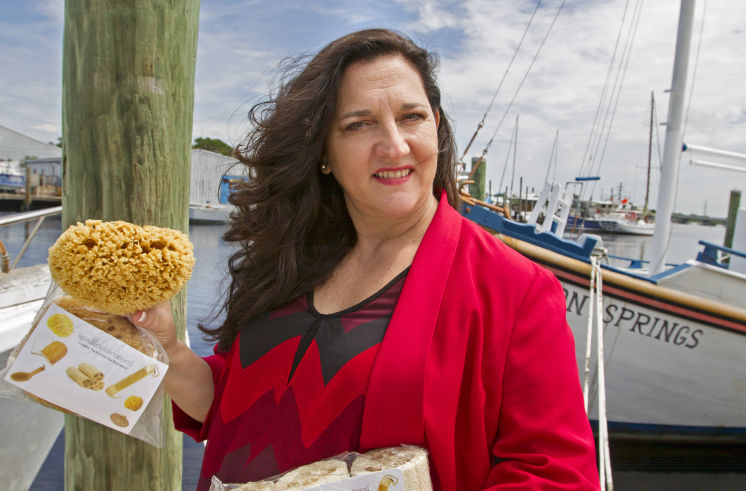By Justine Griffin
Tampa Bay Times, St. Petersburg, Fla.
WWR Article Summary (tl;dr) More than half of the items sold on Amazon worldwide are through small businesses and entrepreneurs. This article takes a look one Tampa entrepreneur’s experience using the online marketplace.
TARPON SPRINGS
When Theo Prodromitis was looking for a way to revamp her in-home party business selling sponges sourced locally from the Sponge Docks, she went online.
There are dozens of ecommerce platforms for entrepreneurs to sell products to virtually anyone, anywhere on the Internet — Walmart.com, Jet.com, Etsy.com, and Ebay.com are just a few that work with third-party sellers. But Prodromitis chose the biggest one of all: Amazon Marketplace.
Prodromitis, who lives in South Tampa but grew up in a Greek family in the Tarpon Springs community, is one of more than two million users from 170 different countries who sell their merchandise on Amazon Marketplace. Those sellers sold a record-breaking 2 billion products during the first half of 2017, according to statistics from Amazon. More than half of the items sold on Amazon worldwide are through small businesses and entrepreneurs.
“Amazon wants more sellers because it keeps bringing new product to their platform,” said James Thomson, a partner in the Buy Box Experts consulting group and the former head of Amazon Services, the division of Amazon responsible for recruiting sellers annually.
“They will select specific sellers that they think will be successful and help them. They have very good metrics and measure sales performance closely. So Amazon is happy to lend you money, especially if they have your product as collateral already in their warehouses.”
Prodromitis began her business, Spa Destinations, as an in-home party company in 2003, similar to the Avon makeup or Tupperware at-home party models.
She also sold her lines of shampoo, moisturizing creams, and her signature collection of natural sponges to salon industry professionals.
Business was booming for years — enough for Prodromitis to expand and offer excursions to European and other worldly destinations to visit renowned spas and learn about different cultures’ beauty secrets.
But business slumped during the Great Recession, Prodromitis became a new mom and the at-home party model fell out of style.
With more than 300 million active customers at Amazon.com, Prodromitis said the choice where to relaunch was simple. She set up her Amazon storefront officially in 2014. It cost her $39.99 to get started. Her business has grown exponentially since then, quadrupling in the first year and spiking by 30 percent in the second. She says she’s on pace to grow even more this year.
What she likes about Amazon’s platform is how easy it is to sell and focus on the important parts of growing her business. Amazon’s Marketplace program essentially does the web marketing, warehousing, packing and shipping for her.
“Amazon does all the things for me that I’m not as skilled in. They fulfill orders for me and manage my whole supply chain,” she said. “So I can focus on what I’m good at, like marketing my brand and building a better customer experience.”
Amazon makes money by charging an 8 to 20 percent commission on items sold, Thomson said.
One sign of Prodromits’ success: she received a coveted invitation to the company’s first Women’s Entrepreneur Conference last year, which drew 300 ecommerce merchants to Amazon’s headquarters in Seattle. There she was able to network with other sellers and ask questions face-to-face with some of Amazon’s management team.
“Amazon isn’t competing with you. They want you to succeed,” she said. “It’s a great place to find your niche and reach people who enjoy that same niche from all over.”
Prodromitis said that she considered trying other platforms, like Jet.com or even HSN (which is based in St. Petersburg,) but said the perks of Amazon far outweighed those of its online competitors.
“There’s so much feedback. Amazon has a forum for sellers that very active. They’re always checking in and so responsive,” she said.
It’s no wonder. Nearly 90 percent of U.S. consumers said Amazon is the ecommerce site they use the most, according to a survey by RBC Capital Markets, which estimates that Amazon controls nearly 20 percent all U.S. online sales.
While that’s good news for Prodromitis and other small businesses, it’s not great news for bigger brands, from Nike to Victoria’s Secret, which are constantly struggling to stand out on their own platforms online, even though their products are sold on Amazon too.
Amazon has become a major disrupter for all brick-and-mortar retailers as it opens its own grocery and book stores, and continues to zoom ahead in the online sphere.
But small businesses do give up some of their own power, and branding, when they choose to sell on Amazon.
Consumers know they bought a sponge on Amazon, but not necessarily from “Spa Destinations” on Amazon.
But Prodromitis is happy with the tradeoff. She secured a business loan through Amazon’s lending services to test and launch a new product line. Amazon tracks its sellers’ growth and gives loans based on what it thinks the return will be, Thomson explained.
“It’s all about the customer with Amazon,” Thomson said. “Amazon offers a better user experience than anyone else right now, that’s for sure. With Prime and Prime Now services and so much product to choose from, they are the ultimate level of convenience. I don’t see Jet.com or Walmart or Ebay or even traditional brick and mortar stores matching that any time soon. That’s a really high bar.”














































































































































































































































































































































































